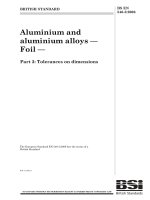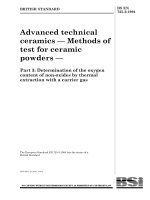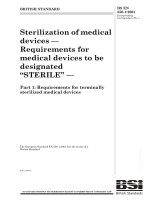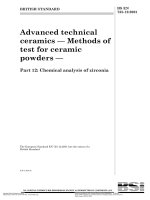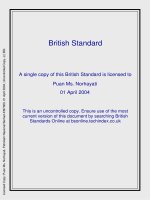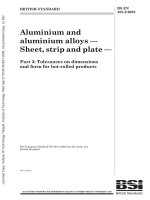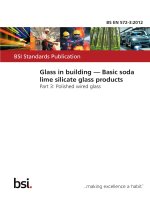Bsi bs en 50325 3 2001
Bạn đang xem bản rút gọn của tài liệu. Xem và tải ngay bản đầy đủ của tài liệu tại đây (704 KB, 64 trang )
Licensed Copy: :FULLNAME, : DATE, Uncontrolled Copy, (c) BSI
BRITISH STANDARD
Industrial
communications
subsystem based on
ISO 11898 (CAN) for
controller-device
interfaces —
Part 3: Smart Distributed System (SDS)
The European Standard EN 50325-3:2001 has the status of a
British Standard
ICS 43.180
NO COPYING WITHOUT BSI PERMISSION EXCEPT AS PERMITTED BY COPYRIGHT LAW
BS EN
50325-3:2001
BS EN 50325-3:2001
National foreword
This British Standard is the official English language version of
EN 50325-3:2001.
Licensed Copy: :FULLNAME, : DATE, Uncontrolled Copy, (c) BSI
The UK participation in its preparation was entrusted to Technical Committee
AMT/7, Monitoring and control aspects of AMT, which has the responsibility
to:
—
aid enquirers to understand the text;
—
present to the responsible European committee any enquiries on the
interpretation, or proposals for change, and keep the UK interests
informed;
—
monitor related international and European developments and
promulgate them in the UK.
A list of organizations represented on this committee can be obtained on
request to its secretary.
Textual errors
The textual errors set out below were discovered when the English language
version of EN 50325-3:2001 was adopted as the national standard. They have
been reported to CENELEC in a proposal to amend the text of the European
Standard.
The ratified text of this document contains extra lettering in Table 3, Table 4,
Table 5, Table 6, Table 7, Table 8 and Table 9. In this standard this extra
lettering has been removed.
Cross-references
The British Standards which implement international or European
publications referred to in this document may be found in the BSI Standards
Catalogue under the section entitled “International Standards Correspondence
Index”, or by using the “Find” facility of the BSI Standards Electronic
Catalogue.
A British Standard does not purport to include all the necessary provisions of
a contract. Users of British Standards are responsible for their correct
application.
This British Standard, having
been prepared under the
direction of the DISC Board,
was published under the
authority of the Standards
Committee and comes into
effect on 15 July 2001
Compliance with a British Standard does not of itself confer immunity
from legal obligations.
Summary of pages
This document comprises a front cover, an inside front cover, the EN title page,
pages 2 to 60, an inside back cover and a back cover.
The BSI copyright date displayed in this document indicates when the
document was last issued.
Amendments issued since publication
Amd. No.
BSI 07-2001
ISBN 0 580 37947 7
Date
Comments
EUROPEAN STANDARD
EN 50325-3
NORME EUROPÉENNE
EUROPÄISCHE NORM
April 2001
ICS 43.180
Licensed Copy: :FULLNAME, : DATE, Uncontrolled Copy, (c) BSI
English version
Industrial communications subsystem based on ISO 11898 (CAN)
for controller-device interfaces —
Part 3: Smart Distributed System (SDS)
This European Standard was approved by CENELEC on 2000-04-01. CENELEC members are bound
to comply with the CEN/CENELEC Internal Regulations which stipulate the conditions for giving this
European Standard the status of a national standard without any alteration.
Up-to-date lists and bibliographical references concerning such national standards may be obtained on
application to the Central Secretariat or to any CENELEC member.
This European Standard exists only in English. A version in any other language made by translation
under the responsibility of a CENELEC member into its own language and notified to the Central
Secretariat has the same status as the official version.
CENELEC members are the national electrotechnical committees of Austria, Belgium, Czech Republic,
Denmark, Finland, France, Germany, Greece, Iceland, Ireland, Italy, Luxembourg, Netherlands, Norway,
Portugal, Spain, Sweden, Switzerland and United Kingdom.
CENELEC
European Committee for Electrotechnical Standardization
Comité Européen de Normalisation Electrotechnique
Europäisches Komitee für Elektrotechnische Normung
Central Secretariat: rue de Stassart 35, B - 1050 Brussels
© 2001 CENELEC - All rights of exploitation in any form and by any means reserved worldwide for CENELEC members.
Ref. No. EN 50325-3:2001 E
Page 2
EN 50325-3:2001
Foreword
This European Standard was prepared by the Technical Committee CENELEC TC 65CX, Fieldbus.
Licensed Copy: :FULLNAME, : DATE, Uncontrolled Copy, (c) BSI
The text of the draft was submitted to the Unique Acceptance Procedure and was approved by CENELEC as
EN 50325-3 on 2000-04-01.
The following dates were fixed:
– latest date by which the EN has to be implemented
at national level by publication of an identical
national standard or by endorsement
(dop)
– latest date by which the national standards conflicting
with the EN have to be withdrawn
(dow) 2003-04-01
2001-10-01
EN 50325 is divided into three parts:
Part 1
General requirements
Part 2
DeviceNet
Part 3
Smart Distributed System (SDS)
The specifications for DeviceNet and SDS are based on ISO 11898 Controller area network (CAN) for
high-speed communication, a broadcast-oriented communications protocol. However, ISO 11898 specifies only
part of a complete communication system, and additional specifications are needed for other layers to ensure
precise data exchange functionality and support of inter-operating devices. The DeviceNet and SDS
specifications build on ISO 11898 to describe a complete industrial communication system.
© BSI 07-2001
Page 3
EN 50325-3:2001
Contents
Introduction .................................................................................................................................... 5
Licensed Copy: :FULLNAME, : DATE, Uncontrolled Copy, (c) BSI
General information on licensing ............................................................................................... 6
1
Scope............................................................................................................................................... 7
2
Normative references..................................................................................................................... 7
3
Definitions, abbreviations and symbols ...................................................................................... 8
3.1 Definitions ................................................................................................................................. 8
3.1.1
3.1.2
3.1.3
3.1.4
3.1.5
3.1.6
3.1.7
3.1.8
3.1.9
3.1.10
3.1.11
3.1.12
3.1.13
3.1.14
3.1.15
3.1.16
3.1.17
3.1.18
Application Layer................................................................................................................................8
Application Layer Protocol (ALP) .......................................................................................................8
Application Layer Protocol Data Unit (APDU) ....................................................................................8
Application Layer Service...................................................................................................................8
Autobaud............................................................................................................................................8
Change Of State (COS) .....................................................................................................................8
Change Of Value (COV) ....................................................................................................................8
Confirm ..............................................................................................................................................8
Data Link Layer Protocol Data Unit (DLPDU) ...................................................................................8
Embedded Object ..............................................................................................................................8
Embedded Object Identifier................................................................................................................8
Indication............................................................................................................................................9
Logical Device....................................................................................................................................9
Network ..............................................................................................................................................9
Object Model......................................................................................................................................9
Physical Component ..........................................................................................................................9
Physical Layer Interface PLI ..............................................................................................................9
Primitive .............................................................................................................................................9
3.2 Abbreviations ................................................................................................................................. 9
3.3 Symbols .................................................................................................................................... 9
3.3.1
3.3.2
3.3.3
(+) ......................................................................................................................................................9
(-) .....................................................................................................................................................10
(=) ....................................................................................................................................................10
4
Relationship with the OSI Reference Model .............................................................................. 10
5
Characteristics ............................................................................................................................. 10
5.1 SDS Network .......................................................................................................................... 10
5.1.1
5.1.2
5.1.3
Network ............................................................................................................................................10
Modelling..........................................................................................................................................11
Hierarchy..........................................................................................................................................12
5.2 SDS Application Layer Services............................................................................................. 13
5.2.1
5.2.2
5.2.3
5.2.4
5.2.5
5.2.6
5.2.7
5.2.8
5.2.9
Service conventions .........................................................................................................................13
Read service ...................................................................................................................................16
Write service ....................................................................................................................................16
Event service ...................................................................................................................................17
Action service...................................................................................................................................18
Change Of State ON (COS ON) service .........................................................................................18
Change Of State OFF (COS OFF) service.....................................................................................19
Write State ON (WRITE ON) service .............................................................................................19
Write State OFF (WRITE OFF) service............................................................................................19
5.3 SDS Application Layer Protocol ............................................................................................. 20
5.3.1
5.3.2
5.3.3
5.3.4
Application Protocol Data Unit (APDU) ...........................................................................................20
APDU Forms ....................................................................................................................................21
Error Codes......................................................................................................................................27
Data types........................................................................................................................................28
5.4 SDS APDUs embedded in CAN frames................................................................................. 32
5.5 Example Short Form APDUs.................................................................................................. 35
5.6 Example Long Form APDUs .................................................................................................. 36
6
Product information ..................................................................................................................... 37
6.1 Instructions for installation, operation and maintenance ........................................................ 37
6.2 Marking ................................................................................................................................... 37
© BSI 07-2001
Page 4
EN 50325-3:2001
7
Normal service, transport and mounting conditions ............................................................... 37
7.1 Normal service conditions ...................................................................................................... 37
7.1.1
7.1.2
7.1.3
7.1.4
7.1.5
7.1.6
General ............................................................................................................................................37
Ambient air temperature...................................................................................................................37
Altitude .............................................................................................................................................37
Humidity ...........................................................................................................................................37
Pollution degree ...............................................................................................................................37
Sealed connectors ...........................................................................................................................37
Licensed Copy: :FULLNAME, : DATE, Uncontrolled Copy, (c) BSI
7.2 Conditions during transport and storage ................................................................................ 37
7.3 Mounting ................................................................................................................................. 37
8
Constructional and performance requirements........................................................................ 38
8.1 SDS Physical Layer Interface (PLI) ....................................................................................... 38
8.1.1
8.1.2
8.1.3
8.1.4
SDS power PLI................................................................................................................................38
Transceivers ....................................................................................................................................38
Transceiver specifications................................................................................................................39
Indicating means ..............................................................................................................................40
8.2 SDS Network .......................................................................................................................... 40
8.2.1
8.2.2
8.2.3
Topology ..........................................................................................................................................40
SDS power distribution.....................................................................................................................42
Auxiliary power ground connection ..................................................................................................42
8.3 Electromagnetic Compatibility (EMC)..................................................................................... 42
8.3.1
8.3.2
8.3.3
8.3.4
9
General requirements for electromagnetic compatibility tests ........................................................42
General test conditions for electromagnetic compatibility tests ......................................................42
Immunity requirements ...................................................................................................................43
Emission requirements ...................................................................................................................45
SDS Communication channel type tests.................................................................................... 45
9.1 General ................................................................................................................................... 45
9.2 Product Model......................................................................................................................... 45
9.3 Object Model test.................................................................................................................... 46
9.3.1
9.3.2
9.3.3
9.3.4
9.3.5
9.3.6
General ............................................................................................................................................46
Attributes..........................................................................................................................................46
Actions .............................................................................................................................................47
Events ..............................................................................................................................................47
Short form services COS ON and COS OFF ................................................................................47
Short form services WRITE ON and WRITE OFF.........................................................................47
9.4 Physical Layer Test ................................................................................................................ 48
9.4.1
9.4.2
9.4.3
9.4.4
9.4.5
Transceiver functional test ...............................................................................................................48
Transceiver Input Resistance...........................................................................................................48
Transceiver input levels ...................................................................................................................48
Transceiver output levels .................................................................................................................49
SDS power .......................................................................................................................................50
9.5 Application Layer Test ............................................................................................................ 51
9.5.1
9.5.2
9.5.3
ALP Services ...................................................................................................................................51
Logical Device functions ..................................................................................................................56
Network functions.............................................................................................................................57
9.6 System test ............................................................................................................................. 58
9.6.1
9.6.2
9.6.3
9.6.4
System test set-up ...........................................................................................................................58
Non-participative system testing ......................................................................................................58
Participative system testing..............................................................................................................58
Other basic system testing...............................................................................................................59
9.7 Electromagnetic Compatibility Test ........................................................................................ 59
9.7.1
9.7.2
General ............................................................................................................................................59
Fast transient/burst immunity ...........................................................................................................59
© BSI 07-2001
Page 5
EN 50325-3:2001
Introduction
Licensed Copy: :FULLNAME, : DATE, Uncontrolled Copy, (c) BSI
The Smart Distributed System (SDS) is intended for use in, but is not limited to, industrial automation
applications. These applications may include devices such as limit switches, proximity sensors,
electro-pneumatic valves, relays, motor starters, operator interface panels, analogue inputs, analogue
outputs, and controllers.
SDS provides for the connection of intelligent devices such as sensors, actuators and other components to
one or more controllers. SDS functionality may be integrated directly into the devices or be in modules
allowing the connection of conventional components to the network.
The SDS network consists of one or more controllers connected to up to 126 Logical Devices. In addition to
the process data, SDS allows for the transmission of parameters and diagnostic data. The data exchange
may be either event driven, cyclical, multicast or polled. A maximum of 6 bytes of data may be transmitted
without fragmentation.
Topology is typically a single trunk with short branches using a cable comprising two shielded, twisted pairs
with a common earth wire all within a single jacket.
Data is transmitted at rates of 125 kbit/s, 250 kbit/s, 500 kbit/s and 1Mbit/s with maximum system trunk
lengths of 457 m, 182 m, 91 m and 22 m respectively.
Detailed information on the performance is contained in clause 5.
Figure 1 shows an example of an SDS Network.
Physical
Component
Sensor
Solenoid
Motor
Controller
Termination
Resistor is
included in the
controller.
Branch
Controller
Termination
Resistor
Tee
Trunk
Figure 1 - Example of an SDS Network
© BSI 07-2001
Page 6
EN 50325-3:2001
General information on licensing
Licensed Copy: :FULLNAME, : DATE, Uncontrolled Copy, (c) BSI
CENELEC calls attention to the fact that patent rights are linked to EN 50325-3 (Part 3: Smart Distributed
System). The patent holder, Honeywell Inc., has assured to CENELEC that it is willing to grant a licence
under these patents on reasonable and non discriminatory terms and conditions to anyone wishing to obtain
such a license, applying the rules of CEN/CENELEC Memorandum 8.
Honeywell’s undertakings (policy letter on licensing, the license offer and the form of license) in this respect
are on file with CENELEC and available for inspection by all interested parties at the CENELEC Central
Secretariat.
The license details may be obtained from:
The Director
(Industrial Marketing and Applied Technology Sensing and Controls Europe)
Honeywell Control Systems Ltd.
Newhouse Industrial Estate,
Motherwell,
Lanarkshire
Scotland ML1 5SB
GB
© BSI 07-2001
Page 7
EN 50325-3:2001
1 Scope
Licensed Copy: :FULLNAME, : DATE, Uncontrolled Copy, (c) BSI
This Part of EN 50325 specifies the following particular requirements for Smart Distributed System (SDS).
-
Requirements for interfaces between control devices and switching elements,
-
Normal service conditions for devices,
-
Constructional and performance requirements,
-
Tests to verify conformance to requirements.
2 Normative references
This Part of EN 50325 incorporates by dated or undated reference, provisions from other publications. These
normative references are cited at the appropriate places in the text and the publications are listed hereafter.
For dated references, subsequent amendments to or revisions of any of these publications apply to this Part
only when incorporated in it by amendment or revision. For undated references the latest edition of the
publication referred to applies.
EN 55011
1998
Industrial, scientific and medical (ISM) radio-frequency equipment –
Radio disturbance characteristics, limits and methods of
measurement
(CISPR 11:1997, mod.)
EN 60947-1
1999
Low-voltage switchgear and controlgear
Part 1: General rules
(IEC 60947-1:1999, mod.)
EN 61000-4-2
1995
Electromagnetic compatibility (EMC)
Part 4-2: Testing and measurement techniques - Electrostatic
discharge immunity test (IEC 61000-4-2:1995)
EN 61000-4-3
1996
Electromagnetic compatibility (EMC)
Part 4-3: Testing and measurement techniques - Radiated,
radio-frequency, electromagnetic field immunity test
(IEC 61000-4-3:1995, mod.)
EN 61000-4-4
1995
Electromagnetic compatibility (EMC)
Part 4-4: Testing and measurement techniques - Electrical fast
transient/burst immunity test (IEC 61000-4-4:1995)
EN 61000-4-5
1995
Electromagnetic compatibility (EMC)
Part 4-5: Testing and measurement techniques - Surge immunity test
(IEC 61000-4-5:1995)
EN 61000-4-6
1996
Electromagnetic compatibility (EMC)
Part 4-6: Testing and measurement techniques - Immunity to
conducted disturbances, induced by radio-frequency fields
(IEC 61000-4-6:1996)
EN 61131-3
1993
Programmable controllers - Part 3: Programming languages
(IEC 61131-3:1993)
ISO/IEC 7498-1
1994
Information technology - Open Systems Interconnection
Part 1: Basic Reference Model: The Basic Model
ISO TR 8509
1987
Information Processing Systems, Open Systems Interconnection,
Service Conventions
ISO 11898
1993
Road vehicles - Interchange of digital information - Controller area
network (CAN) for high-speed communication
© BSI 07-2001
Page 8
EN 50325-3:2001
3 Definitions, abbreviations and symbols
3.1 Definitions
For the purposes of this Part, the following specific terms and definitions apply.
3.1.1 Application Layer
Licensed Copy: :FULLNAME, : DATE, Uncontrolled Copy, (c) BSI
seventh layer of the ISO/OSI Reference Model (see ISO/IEC 7498-1)
3.1.2 Application Layer Protocol (ALP)
rules governing the structure and timing of Application Layer Protocol Data Units that are used to achieve the
services provided by the application layer
3.1.3 Application Layer Protocol Data Unit (APDU)
unit of data transfer exchanged between application layers. It is encapsulated within a Data Link Layer
Protocol Data Unit (DLPDU) when transmitted from one component to another
3.1.4 Application Layer Service
service provided to the Service User of the application layer. The service may be provided by means of a
specified function call
3.1.5 Autobaud
network process for determining the network communication baud rate
3.1.6 Change Of State (COS)
report that a binary device has changed state
3.1.7 Change Of Value (COV)
report that a device input value has changed by a predetermined amount
3.1.8 Confirm
representation of an interaction in which a Service Provider indicates, at a particular service access point,
completion of some procedure previously invoked, at that service access point, by an interaction represented
by a request Primitive. The Confirm is an Application Layer Primitive service. A Confirm notifies the Service
User of the presence of the response (ISO TR 8509)
3.1.9 Data Link Layer Protocol Data Unit (DLPDU)
protocol data unit at the data link layer
3.1.10 Embedded Object
network-addressable entity within a Logical Device. The Embedded Object may be e.g. an embedded
interface, an embedded device, an embedded function or an embedded function block
3.1.11 Embedded Object Identifier
5 bit Application Protocol Data Unit field that holds a number used to differentiate between up to 32
Embedded Objects in a Logical Device
© BSI 07-2001
Page 9
EN 50325-3:2001
3.1.12 Indication
representation of an interaction in which an Application Layer Protocol Service Provider indicates that a
procedure has been invoked by the Application Layer Protocol Service User at the peer service access point.
The Indication is an Application Layer Primitive service. The Indication notifies the Service User of the
presence of a request from another device or controller (ISO TR 8509)
Licensed Copy: :FULLNAME, : DATE, Uncontrolled Copy, (c) BSI
3.1.13 Logical Device
separate addressable entity within a Physical Component. A Logical Device is connected to the
communications channel via its logical address
3.1.14 Network
all the physical media, connectors, associated communication elements and a given set of communicating
devices interconnected for the purpose of communication
3.1.15 Object Model
description of behaviour and structure that comprises a set of attributes, a set of actions and a set of events
3.1.16 Physical Component
single or modular physical package, including hardware and software and containing one or more Logical
Devices, that is connected to the Network
3.1.17 Physical Layer Interface PLI
interface between the Physical Component and the communications media
3.1.18 Primitive
implementation-independent representation of an interaction between a Service User and a Service
Provider. Primitive services exist at the Application Layer level. The Primitives are: Request, Response,
Indication and Confirm (ISO TR 8509)
3.2 Abbreviations
3.2.1 CAN
Controller Area Network
3.2.2 EOID
Embedded Object Identifier
3.2.3 FI
Fragmentation Indicator
3.2.4 R/R
Request/Response
3.2.5 RTR
Remote Transmission Request
3.2.6 EUT
Equipment under Test
3.3 Symbols
3.3.1 (+)
qualifying suffix used with Result parameter service descriptions. As a Result qualifier, it refers to a
successful result in Service Convention diagrams
© BSI 07-2001
Page 10
EN 50325-3:2001
3.3.2 (-)
qualifying suffix used with Result parameter service descriptions. As a Result qualifier, it refers to an
unsuccessful result in Service Convention diagrams
3.3.3 (=)
Licensed Copy: :FULLNAME, : DATE, Uncontrolled Copy, (c) BSI
qualifying prefix used with Indication and Confirm Primitive service descriptions in Service Convention
diagrams. It means that the Primitive is the same as one occurring at a previous level
4 Relationship with the OSI Reference Model
The SDS protocol is based on a three-layer architecture.
NOTE 1 These layers constitute a collapsed form of the OSI (Open Systems Interconnection) seven layer architecture,
mapping onto the physical, data link, and application layers of the OSI Reference Model (ISO/IEC 7498-1).
The Application Layer uses the services provided by the V2.0A CAN Specification data link layer of
ISO 11898.
NOTE 2 Figure 2 compares the architecture of the SDS Protocol Model with the OSI Reference Model.
SDS Protocol Model
Corresponding ISO Layers
APPLICATION LAYER
APPLICATION LAYER
|
PRESENTATION LAYER
|
SESSION LAYER
|
TRANSPORT LAYER
|
NETWORK LAYER
CAN DATA LINK LAYER
DATA LINK LAYER
SDS PHYSICAL LAYER
PHYSICAL LAYER
Figure 2 - SDS protocol architecture compared with the OSI Reference Model
5 Characteristics
5.1 SDS Network
5.1.1 Network
An SDS Network consists of Physical Components which include input devices, output devices, PLC
interfaces, PC interfaces and interfaces to other Networks, etc. Physical Components are modelled as
collections of Logical Devices that communicate over a physical medium. Figure 3 shows a logical
representation of an SDS Network.
© BSI 07-2001
Page 11
EN 50325-3:2001
Physical Component
Logical Device
Logical Device
Physical Component
Physical Component
Logical Device
Logical Device
Licensed Copy: :FULLNAME, : DATE, Uncontrolled Copy, (c) BSI
Embedded
Device
Embedded
Interface
Embedded
Device
Embedded
Function
SDS Address
SDS Address
SDS Address
Embedded
Device
Embedded
Device
Embedded
Function
Block
SDS Address
CAN
CAN
CAN
SDS Trunk Cable
Physical Component
Logical Device
Logical Device
Physical Component
Physical Component
Logical Device
Logical Device
Embedded
Device
Embedded
Interface
Embedded
Device
Embedded
Function
SDS Address
SDS Address
SDS Address
Embedded
Device
Embedded
Device
Embedded
Function
Block
SDS Address
CAN
CAN
CAN
SDS Bus Cable
Figure 3 - Logical representation of an SDS Network
5.1.2
Modelling
5.1.2.1 Component Model
Component models represent SDS network visible structure and behaviour of a node. The primary purpose
of modelling is to improve the interoperability and interchangeability of SDS components.
The basic SDS component model structure is shown in graphical form in Figure 4. An SDS Physical
Component contains at least one Logical Device and provides the connection to the Network. A Logical
Device contains at least one and up to 32 SDS Embedded Objects (see 3.1.10). A Physical Component may
have several Logical Devices with different SDS Logical Addresses on the Network.
© BSI 07-2001
Page 12
EN 50325-3:2001
A PHYSICAL COMPONENT CONTAINS
1 TO 126 LOGICAL DEVICES.
THE ACTUAL COMPONENT
THE ADDRESSABLE DEVICE
A LOGICAL DEVICE CONTAINS
1 TO 32 EMBEDDED OBJECTS
OF THE FOLLOWING TYPES:
PHYSICAL COMPONENT
LOGICAL DEVICE
EMBEDDED OBJECT 31
EMBEDDED OBJECT 30
o
o
o
o
I/O DEVICES
FUNCTIONS EN 61131-3
FUNCTION BLOCKS
INTERFACES
EACH SDS OBJECT MODEL INCLUDES:
Licensed Copy: :FULLNAME, : DATE, Uncontrolled Copy, (c) BSI
EMBEDDED OBJECT
EVENTS: 1
ACTIONS:
ATTRIBUTES:
EMBEDDED OBJECT
SUB-ADDRESSABLE OBJECTS
EVENTS:
ACTIONS:
ATTRIBUTES:
CAN
0
EVENTS:
Diagnostic Event
End Of Timer
Change Of State
ACTIONS:
Change Of Value
NOOP
...............
Change Address
Clear ALL errors
ATTRIBUTES:
Self Test
Device Type
........
Catalog Listing
Vendor Number
Software Release Number
Date Code
Device Name
Tag Name
Serial Number
..............
SDS TRUNK
Figure 4 - Graphical representation of Component Model
An SDS Component Model shall include three types of elements: attributes, actions and events. These
elements describe the behaviour of an SDS Embedded Object.
5.1.2.2
Attributes
Attributes are containers for the network visible data. Therefore a device network variables shall include the
collection of attributes defined by each of its Embedded Objects (figure 4). Each attribute shall have a
primitive tag which identifies an associated data type (see 5.3.4) along with data size and/or length
specifications. Attributes may be read-only, read-write, or read-write with password protection.
5.1.2.3
Actions
Actions are SDS Embedded Object services which shall be invoked via an action request message which
may include data. A device services an action in a manner similar to a subroutine call in a software program.
The action response message may also include data.
5.1.2.4 Events
Events are SDS Embedded Object reports. A device shall issue an event as soon as the trigger condition
described in the SDS Object Model is true. An event message may include data.
5.1.3 Hierarchy
NOTE SDS defines a mechanism to organize and manage models. These models are separated into major categories
and arranged hierarchically.
© BSI 07-2001
Page 13
EN 50325-3:2001
Figure 5 shows the overview of the standard SDS hierarchy. The SDS Minimum Model specifies a minimum
set of features that every device shall support. These features shall be inherited by other models such as I/O
Devices, Interface Devices, etc., each of which shall also specify its own set of attributes, actions and events.
These may in turn be inherited by other models which add another set of features. A particular model shall
support the features of all the models it inherits.
Licensed Copy: :FULLNAME, : DATE, Uncontrolled Copy, (c) BSI
SDS
Minimum
Model
1.0
I/O
Device
2.0
EN 61131-3
Function
3.0
SDS
Function
Block
4.0
SDS
Interface
Figure 5 - SDS example of Models in hierarchical form
The topmost level of the hierarchy defines the structure and minimum behaviour of the Physical Component
and Logical Device in the SDS Model. Every SDS product shall include this top level. Each lower level of the
hierarchy defines additional SDS attributes, actions and events for SDS Embedded Objects at that level.
SDS Embedded Objects at each level of the hierarchy shall inherit all of the features from all previous levels.
A Logical Device may contain up to 32 Embedded Objects in any combination.
5.2 SDS Application Layer Services
5.2.1 Service conventions
The Application Layer shall provide the services listed in Table 1.
Table 1 - SDS Application Layer Services
Service
Read
Write
Event
Action
Change Of State–ON
Change Of State–OFF
Write State–ON
Write State–OFF
Function
Allows the ALP service user to read the value of a device attribute.
Allows the ALP service user to modify the value of a device attribute.
Allows an ALP service user to report an event.
Allows an ALP service user to command a device to execute an action.
Specialized event service that reports a Change Of State to the ON
condition of a binary Device Model
Specialized event service that reports a Change Of State to the OFF
condition of a binary Device Model
Specialized write service that writes an ON state to a binary output device
Specialized write service that writes an OFF state to a binary output device
The SDS Service Model uses four primitive functions to provide the Application Layer Services at the CAN
Data Link Layer level: Request, Response, Indication and Confirm. The Primitives are shown in Figure 6 for
the standard service and in Figure 7 for a fragmented service.
© BSI 07-2001
Page 14
EN 50325-3:2001
Initiating Device
Responding Device
Service User
Request
Response
Confirm
1
3
Licensed Copy: :FULLNAME, : DATE, Uncontrolled Copy, (c) BSI
4
Confirm
Application Layer
Indication
2
CAN Data Link Layer
Physical Layer
Response APDU
Request APDU
Figure 6 - Representation of the service Primitives (without fragmentation)
The following description corresponds to the service sequence shown in Figure 6. For example, when a
sender invokes an application layer “Read” service, the following sequence of events occurs.
a) A Request Primitive presented to the Application Layer causes the generation of an Application Layer
Protocol Data Unit by the initiating device.
b) The receipt of the Application Layer Protocol Data Unit by the responding device causes an Indication of
the received message for the Service User at the responding device.
c) The Service User at the responding device presents a Response Primitive to the Application Layer that
causes the generation of an Application Layer Protocol Data Unit.
d) The receipt of this APDU response by the initiating device causes a Confirm Primitive to be delivered to
the Service User at the initiating device.
© BSI 07-2001
Page 15
EN 50325-3:2001
Initiating Device
Responding Device
Service User
Request
1
Response
Confirm
3
Licensed Copy: :FULLNAME, : DATE, Uncontrolled Copy, (c) BSI
Confirm
4
Application Layer
Indication
2
CAN Data Link Layer
Physical Layer
Response APDU
Request APDU (nth fragment)
Request APDU (2nd fragment)
Request APDU (1st fragment)
Figure 7 - Representation of the service Primitives with fragmentation
The Fragmented Service is used for information that exceeds the maximum data length of a single
Application Layer Protocol Data Unit. The following sequence of events occurs.
a) A Request Primitive presented to the Application Layer causes the generation of the individual
fragmented APDUs by the initiating device.
b) The receipt of the last APDU fragment by the responding device causes an Indication of the received
message for the Service User at the responding device.
c) Following receipt of the Indication Primitive, the Service User at the responding device invokes the
Response Primitive on the Application Layer, which causes the generation of a Response ADPU.
d) The receipt of this Response APDU by the initiating device causes a Confirm Primitive to be delivered to
the Service User at the initiating device.
© BSI 07-2001
Page 16
EN 50325-3:2001
5.2.2 Read service
This service shall be used to read an attribute value of an Embedded Object. For example, it could be used
to read the present value of a sensor. Table 2 describes the parameters defined for the read service.
Licensed Copy: :FULLNAME, : DATE, Uncontrolled Copy, (c) BSI
Table 2 - Parameters defined for read service
Parameter
Request
Indication
Response
Logical Address—
EOID
Attribute ID
Mandatory
(=) Request received
Mandatory
Mandatory
(=) Request received
Mandatory
Confirm
Result (+)
Attribute ID
Attribute Value
Conditional
Mandatory (=) Response received
Mandatory (=) Response received
Result (–)
Attribute ID
Error Code
Conditional
Mandatory (=) Response received
Mandatory (=) Response received
The functions of the parameters are as follows:
a) Logical Address identifies the device from which the attribute data is to be read. This is mandatory in
both the Request and the Response.
b) EOID (Embedded Object ID) specifies which of the Embedded Objects is to be read. This is mandatory
in both the Request and the Response.
c) Attribute ID specifies the attribute to be read. The value of the attribute ID is defined in the Object Model
of the Embedded Object. This is mandatory in both Request and Response.
d) Result (+) The Result (+) parameter is returned if the read was successful. It returns the attribute ID and
the value that was read.
e) Result (–) The Result (–) parameter is returned if the read fails. It returns the attribute ID and provides
an error code specifying why the read request failed.
5.2.3 Write service
Shall be used to modify an attribute of an Embedded Object. For example, this service could be used to set
an actuator output to ON or OFF. Table 3 describes the parameters defined for this service.
Table 3 - Parameters defined for write service
Parameter
Request
Indication
Response
Confirm
Logical Address—EOID Mandatory
(=) Request received
Mandatory
(=) Response received
Attribute ID
Mandatory
(=) Request received
Mandatory
(=) Response received
Attribute Value
Mandatory
(=) Request received
Result (+)
Attribute ID
Conditional
Mandatory
(=) Response received
Result (–)
Attribute ID
Error Code
Conditional
Mandatory
Mandatory
(=) Response received
(=) Response received
© BSI 07-2001
Page 17
EN 50325-3:2001
The functions of the parameters are as follows:
a) Logical Address identifies the device to which the attribute data is to be written. This is mandatory in
both the Request and the Response.
b) EOID (Embedded Object ID) specifies which of the Embedded Objects is to be written.
Licensed Copy: :FULLNAME, : DATE, Uncontrolled Copy, (c) BSI
c) Attribute ID specifies the attribute to be written. The value of the ID is defined in the Object Model of the
Embedded Object.
d) Attribute Value is the value to which the attribute is to be set.
e) Result (+) The Result (+) parameter returned with the attribute ID if the write was successful.
f) Result (–) The Result (–) parameter is returned if the write failed. It returns the attribute ID and provides
an error code specifying why the write request failed.
5.2.4 Event service
Shall be used to report the occurrence of events specified for an Embedded Object. For example, a Logical
Device might report a self-test failure. Table 4 describes the parameters defined for this service.
Table 4 - Parameters defined for event service
Parameter
Request
Indication
Response
Confirm
Logical Address—EOID Mandatory
(=) Request received
Mandatory
(=) Response received
Event ID
Mandatory
(=) Request received
Mandatory
(=) Response received
Event Parameters
Conditional
(=) Request received
Result (+)
Event ID
Conditional
Mandatory
(=) Response received
Result (–)
Event ID
Error Code
Conditional
Mandatory
Mandatory
(=) Response received
(=) Response received
The functions of the parameters are as follows:
a) Logical Address identifies the device in which the event occurred.
b) EOID (Embedded Object ID) specifies which of the Embedded Objects is transmitting.
c) Event ID specifies the event that occurred. The value of the event ID is specified in the Object Model of
the sending Embedded Object.
d) Event Parameters The event parameters are conditional on the type of event. They are defined in the
Object Model specifications.
e) Result (+) The Result (+) parameter is returned with the event ID if the event was successful.
f) Result (–) The Result (–) parameter is returned if the event failed. It returns the event ID and provides an
error code specifying why the event failed.
© BSI 07-2001
Page 18
EN 50325-3:2001
5.2.5
Action service
Shall be used to execute the actions specified for an Embedded Object. For example, the action service may
be used to initiate a self-test. Table 5 describes the parameters defined for this service.
Table 5 - Parameters defined for action service
Licensed Copy: :FULLNAME, : DATE, Uncontrolled Copy, (c) BSI
Parameter
Request
Indication
Response
Confirm
Logical Address—EOID Mandatory
(=) Request received
Mandatory
(=) Response received
Action ID
Mandatory
(=) Request received
Mandatory
(=) Response received
Action Parameters
Conditional
(=) Request received
Result (+)
Action ID
Action Results
Conditional
Mandatory
Conditional
(=) Response received
(=) Response received
Result (–)
Action ID
Error Code
Conditional
Mandatory
Mandatory
(=) Response received
(=) Response received
The functions of the parameters are as follows:
a) Logical Address identifies the device to which the action request is to be sent. This is mandatory in both
the Request and the Response.
b) EOID (Embedded Object ID) specifies which of the Embedded Objects is to perform the action.
c) Action ID specifies the action to be performed. The value of the action ID is specified in the Object
Model.
d) Action Parameters are dependent on the type of action. They are defined in the Object Model.
e) Result (+) The Result (+) parameter is returned with the action ID and action parameters.
f) Result (–) The Result (–) parameter is returned if the action request failed. It returns the action ID and
provides an error code specifying why the action request failed.
5.2.6 Change Of State ON (COS ON) service
Shall be used by a Logical Device to report the occurrence of a change of its state to ON. This event service
shall be used by a device which contains only a single binary Embedded Object (e.g., a single binary input).
Table 6 describes the parameters defined for this service.
Table 6 - Parameters defined for Change Of State ON service
Parameter
Logical Address
Request
Mandatory
Indication
(=) Request received
Result (+)
COS ON ACK
Response
Mandatory
Confirm
(=) Response received
Conditional
Mandatory (=) Response received
The functions of the parameters are as follows:
a) Logical Address identifies the device in which the Change Of State to ON occurred.
b) Result (+) A Change of State ON Acknowledge (COS ON ACK) is returned when the report is
successful.
c) Result (–) The Result (–) parameter is not defined for this service.
© BSI 07-2001


